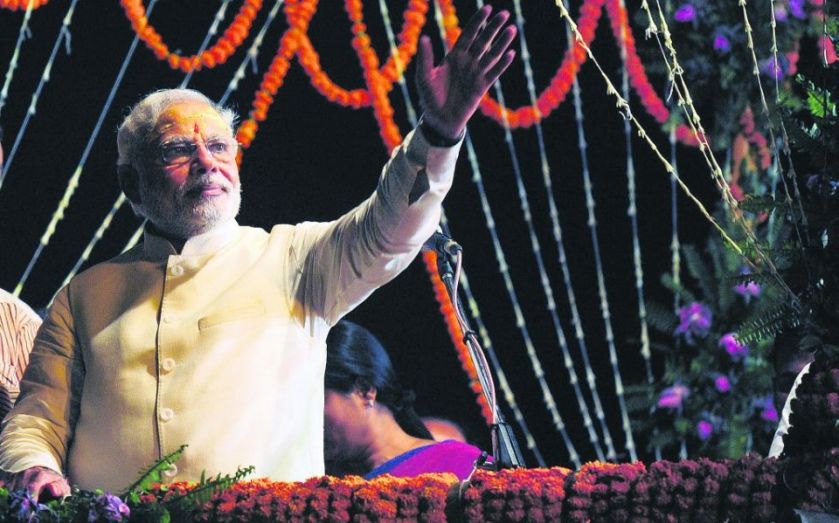| Updated:
The Narendra Modi effect: Why Indian stocks could keep on soaring

Of the 1,559 equity funds monitored by FE Trustnet, the top seven performers over the last 12 months have all been India specialists. Eighth spot is held by a biotech fund, but the next six spots are again occupied by funds focused on India. Out of the top 20 funds, 16 are India equity specialists, and the top two – the Matthews Asia India and Goldman Sachs India Equity funds – have returned 58.7 and 56 per cent respectively since this time last year.
It’s fair to say that surging optimism towards India has been one of the most astonishing stock market themes of the year, driven in large part by the election of reformist Prime Minister Narendra Modi and his Bharatiya Janata Party (BJP) in May. The promise of reforms to increase foreign direct investment and cut red tape helped the MSCI India index rise by over 11 per cent between 1 and 26 May. Reserve Bank of India governor Raghuram Rajan meanwhile, just over a year into his term, is seeing some success in his crusade against inflation – consumer price inflation is now below 7 per cent for the first time since the central bank began using the metric.
But how much of the good news is priced in to Indian markets by now? Mark Dampier of Hargreaves Lansdown points out that there’s a risk of disappointment with expectations so high. And with foreign institutional investors now holding roughly 26 per cent of India’s Sensex stock index, as the chairman of the giant Indian financial conglomerate Housing Development Finance Corp recently pointed out, the risk of rapid outflows is heightened.
FOLLOW-THROUGH IN DELHI?
“Excessive optimism is a real risk with India after such an incredible rally,” says Jason Hollands of Tilney Bestinvest. The public finances are relatively weak (India’s fiscal deficit reached nearly 83 per cent of the government’s full-year target in the first half of the year), corruption is a big problem (Reuters yesterday claimed that nearly a third of Modi’s 66-member cabinet have faced criminal charges), and poor infrastructure has created supply-side bottlenecks to growth. How successful the BJP is in pushing through reforms to alleviate these and other problems will go a long way to deciding how long the current air of optimism lasts, says Hollands.
The government’s plans for fiscal consolidation and reducing state subsidies outlined in its July budget were a positive step, Shweta Singh of Lombard Street Research wrote in a note at the time, as were measures to increase access to capital markets and promote domestic and foreign investment in infrastructure. But Singh pointed out last week that the government is only taking incremental steps, and is yet to announce the “big bang reforms” that many have been expecting.
Given these uncertainties, Hollands thinks that the safest way to gain exposure to any further upsides in the short term is through a global emerging market fund rather than an India specialist, since global managers will have the scope to adjust weightings depending on what happens over the next year. He points out that the JP Morgan Emerging Markets Investment Trust currently has a 20 per cent weighting to India, compared to a benchmark weighting of around 7.1 per cent.
THE NEW ASIAN GIANT?
How plausible are claims that Modi could unleash India’s economic potential and push GDP growth towards China’s levels? The demographic potential is enormous, says Dampier, with the United Nations expecting India to be the world’s most populous country by 2028. Perhaps the most significant obstacle will be the gaping holes in the country’s infrastructure. The Institute of Mechanical Research estimates that 40 per cent of fruit and vegetables are lost in transit in India due to a lack of refrigerated transport, poor roads, inclement weather and corruption.
But there are signs of improvement, say Rajendra Nair and Rukhshad Shroff of JP Morgan Asset Management, with Modi showing a sense of urgency, and a desire to “leave policy paralysis behind.” They forecast that growth will pick up to 7 per cent in 2017, compared to just above 5.2 per cent last year.
Moreover, Singh points out that Modi’s political manoeuvres suggest that he’s serious about pushing reforms through. He quickly combined 17 related ministries into just seven departments to enhance coordination and efficiency, and the BJP’s power over state legislatures (a key battleground for the implementation of legislation) has increased since May. Investors able to ride any short-term jitters could go with the Aberdeen Global Indian Equity fund to play the long-term growth story, says Hollands.